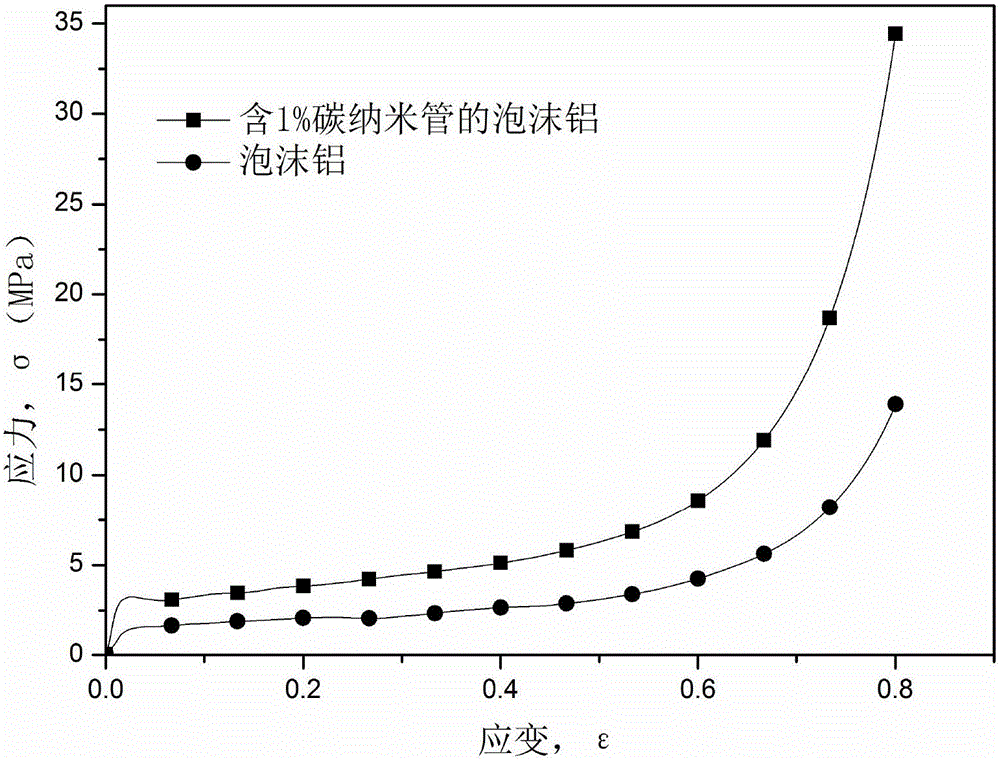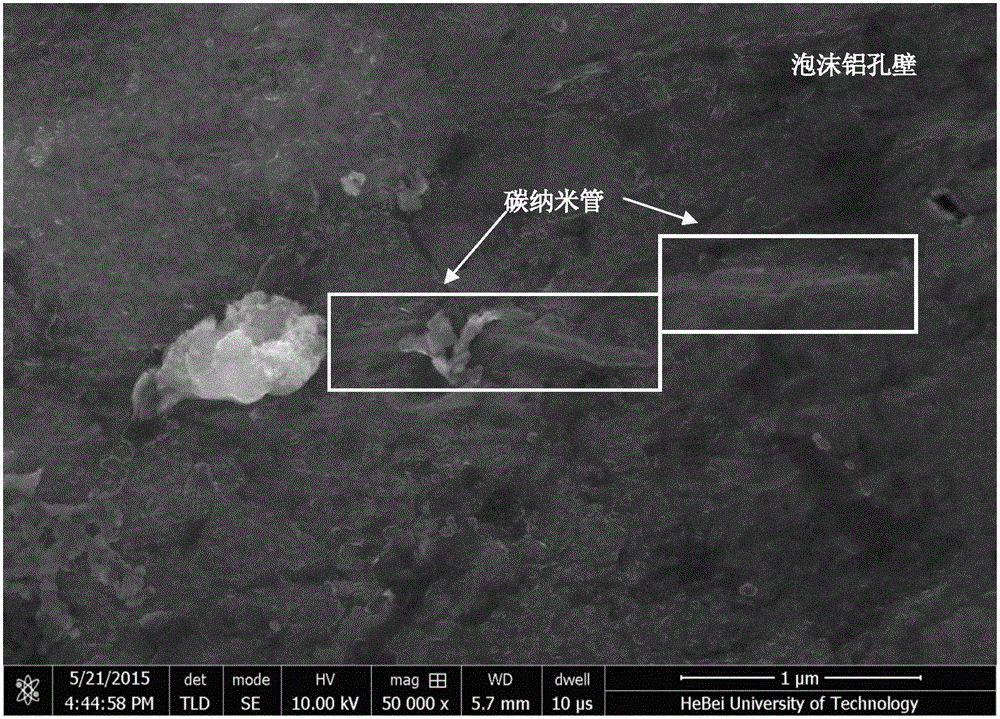Preparing method for foam metal composite material
A composite material and metal foam technology, which is applied in the field of closed-cell metal foam composite material preparation, can solve the problems of not being suitable for the production of large-scale structural materials, poor wettability of metal substrates, and easy aggregation of carbon nanotubes, etc., to achieve low cost, Enhanced interface bonding, simple and stable process
- Summary
- Abstract
- Description
- Claims
- Application Information
AI Technical Summary
Problems solved by technology
Method used
Image
Examples
Embodiment 1
[0040] 1): The aluminum ingot is cut into aluminum sheets with a thickness of 5mm and a diameter of 10mm by a wire cutting machine, and 10 pieces of aluminum sheets with a total mass of 1060g are used as the aluminum substrate for use.
[0041] 2): the multi-walled carbon nanotube (its quality is 1% of the total mass of the aluminum matrix, ) and aluminum powder (analytical pure) are mixed according to the mass ratio of 1:20, using a 500ml woolen jar, 5mm zirconia grinding balls, the mass ratio of the ball to material is 10:1, and ball milling at a speed of 300r / min on a planetary ball mill The mixture 2h.
[0042] 3): Heat up the resistance furnace to 720°C, preheat the crucible in the resistance furnace for 5 minutes, then lift out the crucible, and evenly spray 50ml of zirconia release agent on the inner wall of the crucible (the concentration is 10g of zirconia per 100ml of water) First add a piece of aluminum flake, then evenly add a layer of mixed powder obtained from ...
Embodiment 2
[0050] 1): A wire cutting machine is used to cut the magnesium ingot into magnesium flakes with a thickness of 10 mm and a diameter of 10 mm, and 8 magnesium flakes with a total mass of 1060 g are taken as magnesium substrates for later use.
[0051] 2): the multi-walled carbon nanotube (its quality is 3% of the total mass of the magnesium matrix, ) and magnesium powder (analytical pure) are mixed according to the mass ratio of 1:5, using a 500ml woolen jar, 3mm zirconia grinding balls, the mass ratio of the ball to material is 20:1, and ball milling at a speed of 500r / min on a planetary ball mill The mixture 0.5h.
[0052] 3): Heat up the resistance furnace to 680°C, preheat the crucible in the resistance furnace for 10 minutes, then lift out the crucible, and evenly spray 50ml of zirconia release agent on the inner wall of the crucible (the concentration is 10g of zirconia per 100ml of water), First add a piece of magnesium flakes, then evenly add a layer of mixed powder o...
Embodiment 3
[0057] 1): Use a wire cutting machine to cut the aluminum ingot into round aluminum sheets with a thickness of 10mm and a diameter of 10mm, and take 5 pieces of aluminum sheets with a total mass of 1060g as the aluminum matrix for use.
[0058] 2): the multi-walled carbon nanotube (its quality is 5% of the total mass of the aluminum matrix, ) and aluminum powder (analytically pure) are mixed according to the mass ratio of 1:10, using a 500ml woolen jar, 10mm zirconia grinding balls, the mass ratio of the ball to material is 5:1, and ball milling at a speed of 200r / min on a planetary ball mill The mixture 5h.
[0059] 3): Heat the resistance furnace to 750°C, preheat the crucible in the resistance furnace for 3 minutes, then lift out the crucible, and evenly spray 50ml of zirconia release agent on the inner wall of the crucible (the concentration is 10g of zirconia per 100ml of water), First add a piece of aluminum flake, then evenly add a layer of mixed powder obtained by ba...
PUM
| Property | Measurement | Unit |
|---|---|---|
| thickness | aaaaa | aaaaa |
| melting point | aaaaa | aaaaa |
| diameter | aaaaa | aaaaa |
Abstract
Description
Claims
Application Information
 Login to View More
Login to View More - R&D
- Intellectual Property
- Life Sciences
- Materials
- Tech Scout
- Unparalleled Data Quality
- Higher Quality Content
- 60% Fewer Hallucinations
Browse by: Latest US Patents, China's latest patents, Technical Efficacy Thesaurus, Application Domain, Technology Topic, Popular Technical Reports.
© 2025 PatSnap. All rights reserved.Legal|Privacy policy|Modern Slavery Act Transparency Statement|Sitemap|About US| Contact US: help@patsnap.com



